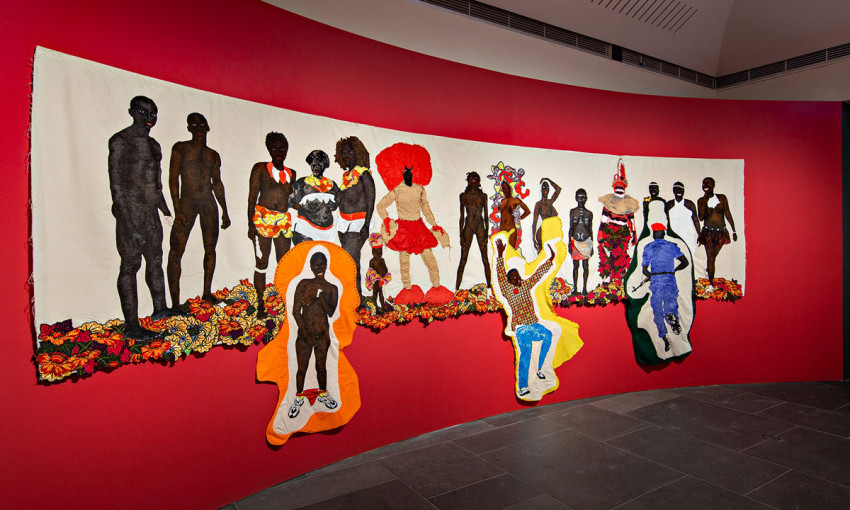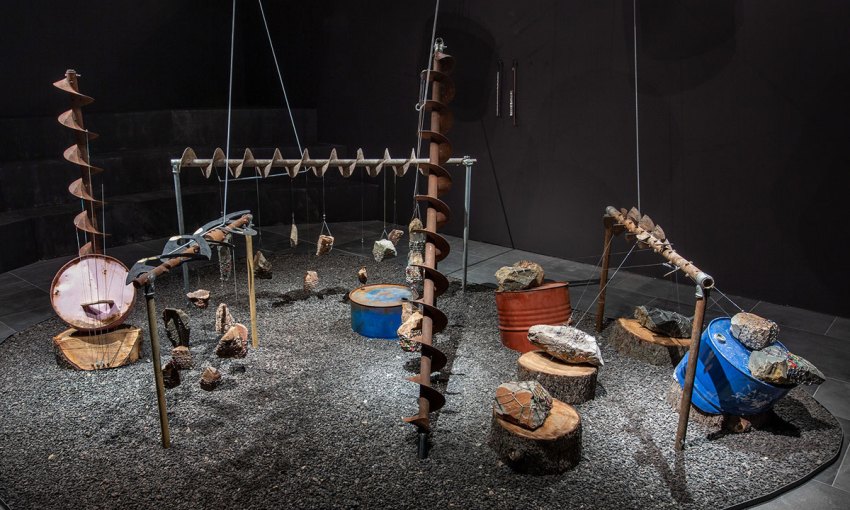The 2020 Adelaide Biennial of Australian Art opens this weekend, with the work of 23 cutting-edge contemporary artists on display and a line-up of live performances and interactive experiences that will bring their monsters to life.
2020 Adelaide Biennial monsters come to life
With the theme Monster Theatres, the 2020 Adelaide Biennial is the culmination of two years’ work for curator Leigh Robb, and she’s clearly thrilled to see the artworks finally installed, spotlit – and in some cases even animated.
“When you finally see all the works taking shape and coming to life in all their different forms, you’re just inspired all over again by what artists can do,” she says on the eve of the official opening tonight.
“Every single thing in this show is incredibly relevant and vibrant, and it just feels like they become more and more relevant every day.”
Robb chose the theme of monsters as a way of bringing together a diverse collection of artists working across media including painting, photography, sculpture, textiles, video, sound art, installation and performance.
She describes their artworks as “warnings made manifest” – addressing the monsters of now.
A number of Biennial works on display at the Art Gallery of South Australia and the Adelaide Botanic Garden have an interactive element. They include pioneering performance artist Stelarc’s 9-metre robot Reclining Stick Man, which occupies a room in the AGSA and can be manipulated by gallery visitors using a keypad.
Reclining Stick Man, created in collaboration with local engineers and Flinders University’s Tonsley Innovation Hub, has a range of movement through 360 degrees.

“If you asked Stelarc the work he has always wanted to create, it’s a giant robot,” Robb says.
“He’s always been interested in this post-human space and the relationship between humans and machines … and also ideas around agency and control.
“There are many ways to choreograph the robot. It’s incredibly elegant, and when it moves it feels like it’s an astronaut in space; it’s almost balletic.”
Stelarc himself will be strapped into Reclining Stick Man for a performance over five hours this Saturday (February 29).
Another work at the AGSA that can be brought to life sonically is Quandamooka artist Megan Cope’s Death Song, a large installation made from old earth-moving, farming and mining equipment like drill bits and augurs fitted with strings.
Death Sound comprises multiple individual instruments that create sounds reminiscent of, for example, a violin, double bass or percussion, and is surrounded by a kind of amphitheatre, like a quarry or mining super-pit. At the AGSA’s First Fridays after-hours event in May it will be played by a group of musicians.
“Her work is, in a way, a sort of requiem for an exploded country or imagining what country would sound like if it could emit a sound or a warning … it has also become a lamentation for burnt country,” Robb says.

Nearby is a work by South Australian artist and 2019 Ramsay Art Prize People’s Choice award winner Pierre Mukeba that defies easy categorisation, incorporating drawing, painting and textiles. Dedicated to his grandmother and titled Kitenge (Part I) and Kitenge (Part II), it is a two-part tableau featuring a series of beautifully rendered African characters, with scenes of traditional ritual and dance overlaid with contrasting images of conflict and violence.
A different kind of tableau can be seen in the work of Queensland multi-disciplinary artist Judith Wright, who has created one of her largest installations ever for Monster Theatres. Tales of Enchantment reflects Wright’s interest in themes of loss, love and impermanence, incorporating small mannequins, human-animal hybrids, angels and other figures to create what Robb describes as a kind of fantastical “secret garden”.
Elsewhere in the AGSA, sitting near the front of a small theatre-like space facing a stage, is Abdul Abdullah’s human-snub-nosed-monkey hybrid Understudy, which was made with a cinematic fabrication company. There is a sense of expectation in watching the spotlit character looking towards the empty stage, which is equipped with a live microphone so it can be used as a kind of soapbox or speaker’s corner.
“It [Understudy] looks so human from the back,” Robb says. “Abdul has described it as a bit of a self-portrait because the mannequin that’s dressed underneath it is modelled on his body.”

One of the 2020 Biennial artists showing work in the Adelaide Botanic Garden is environmentalist Mike Bianco, whose bee experience Anthrocomb explores the spectre of ecological collapse. During this weekend’s exhibition opening, members of the public will be invited to “rest with 50,000 live bees in a participatory experience for the senses”.
Other opening weekend events include a durational reading at the AGSA by performance artist Mike Parr, a musical performance (A Civic Space) at the Freemasons Lodge on Sunday by soundscape artist Julian Day and a brass band and choir from the Barossa Valley, and a program of artist talks and keynote addresses.
“Endurance performance, sound works, arenas for action and listening take the stage in Monster Theatres,” says Robb.
“This exhibition creates encounters with agents of artificial intelligence, the chance to choreograph robots, or to rest and breathe with bees. Agency and power structures will be shifted and redistributed, materialities mutate and morph.”
Monster Theatres opens tonight at the Art Gallery of South Australia and will continue until June 8. Details of the opening weekend events can be found here.



